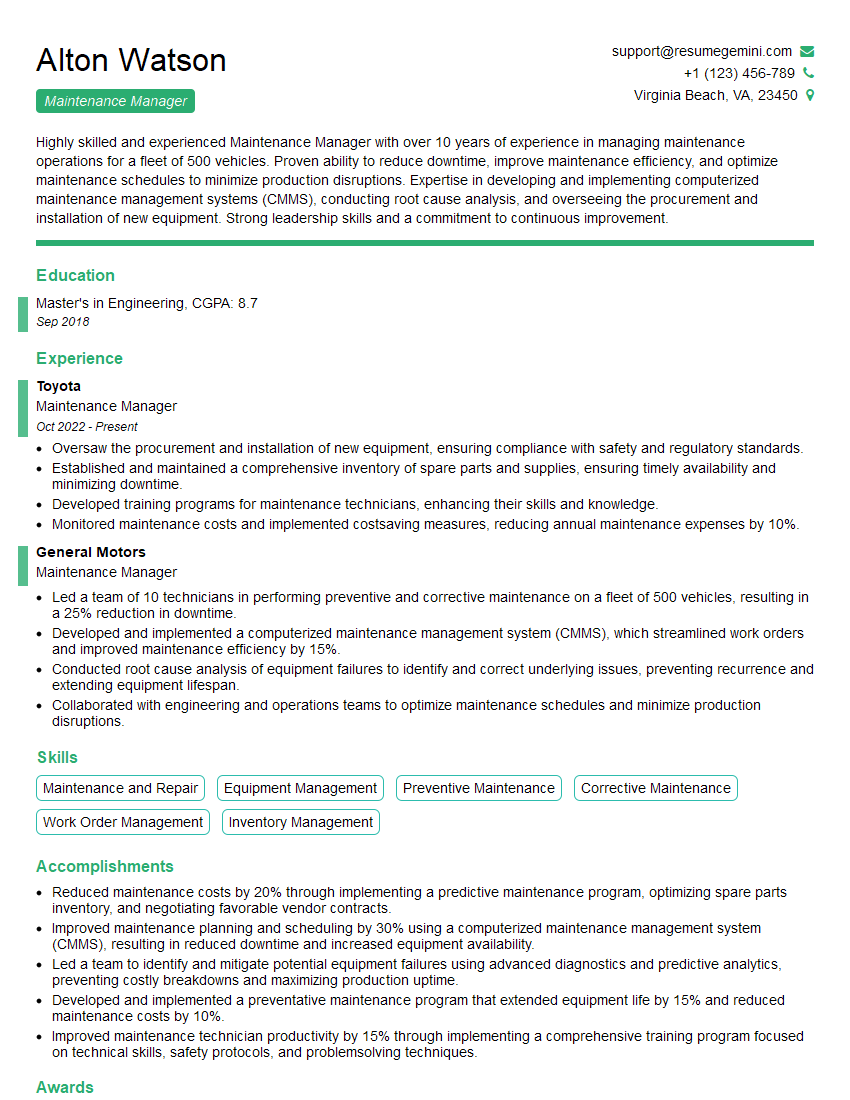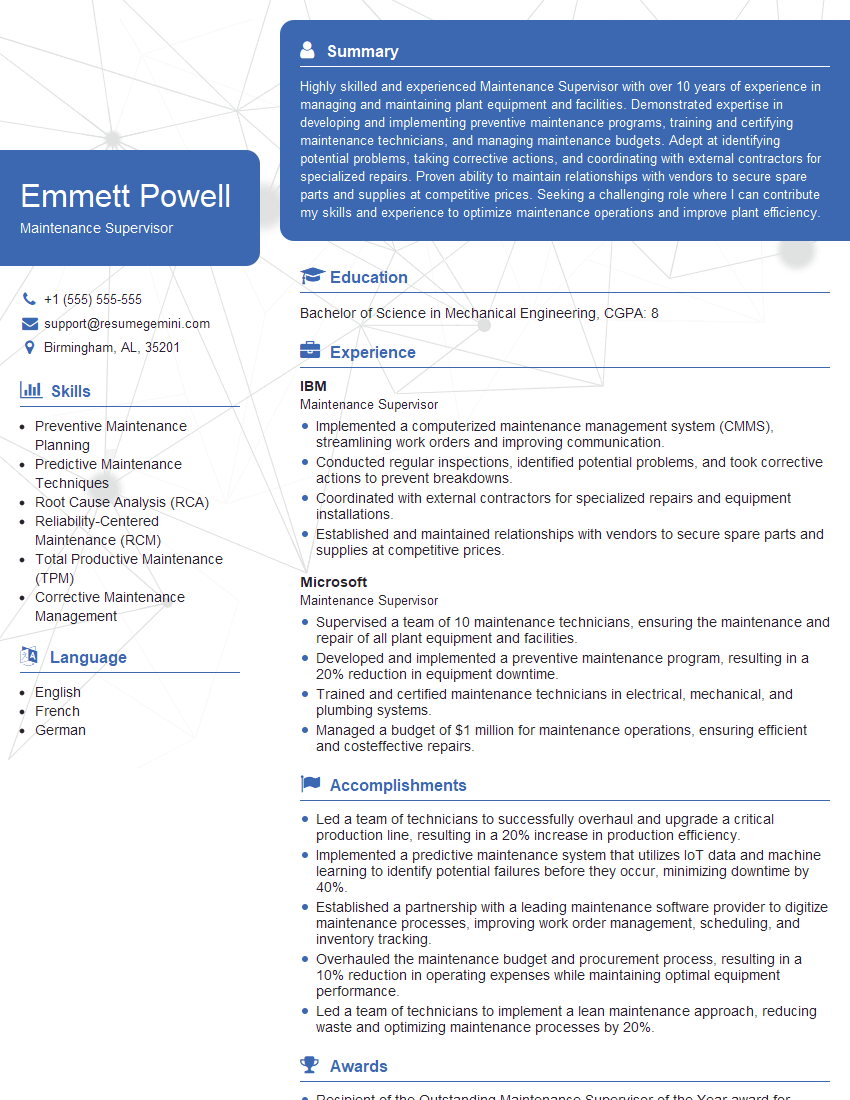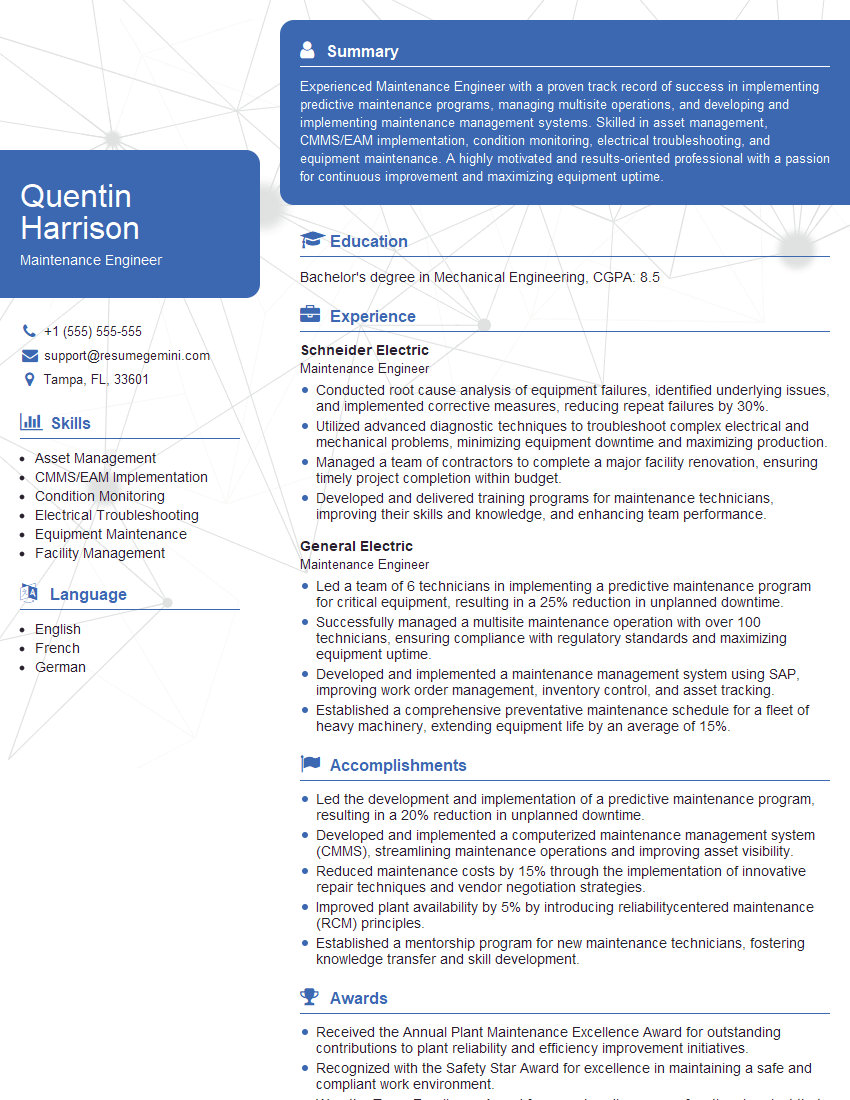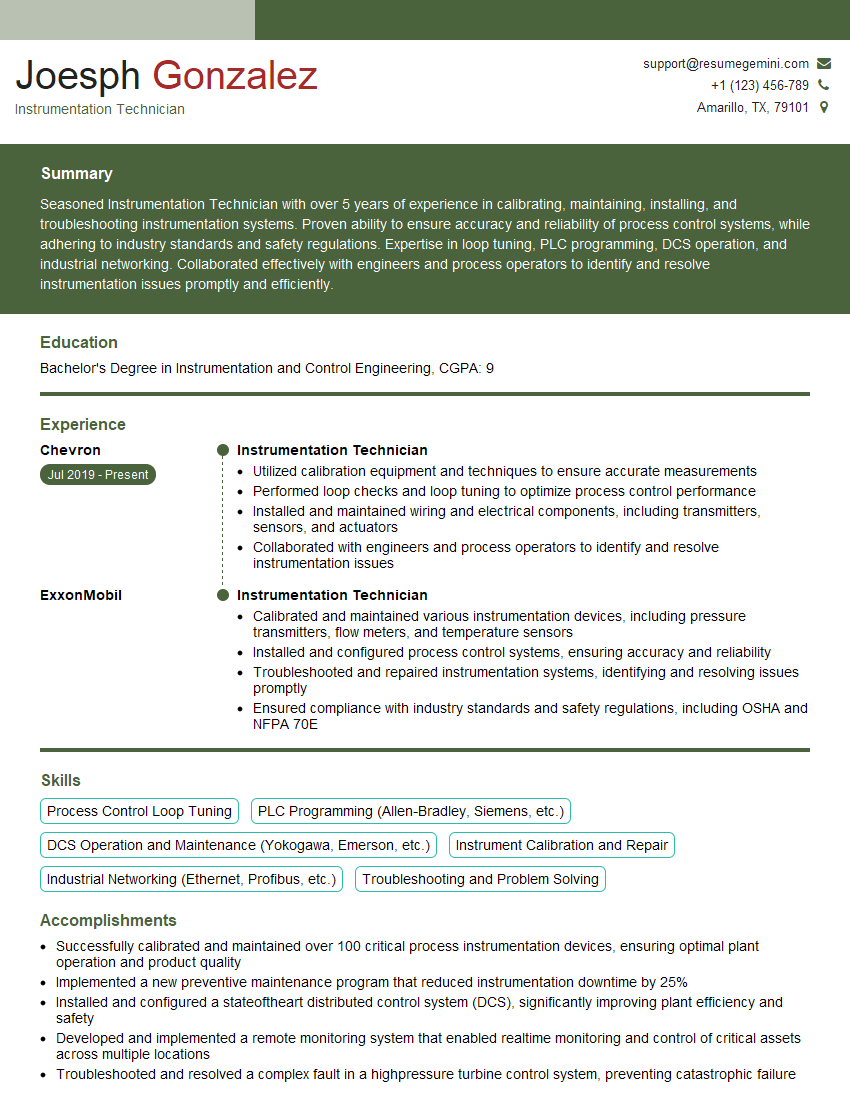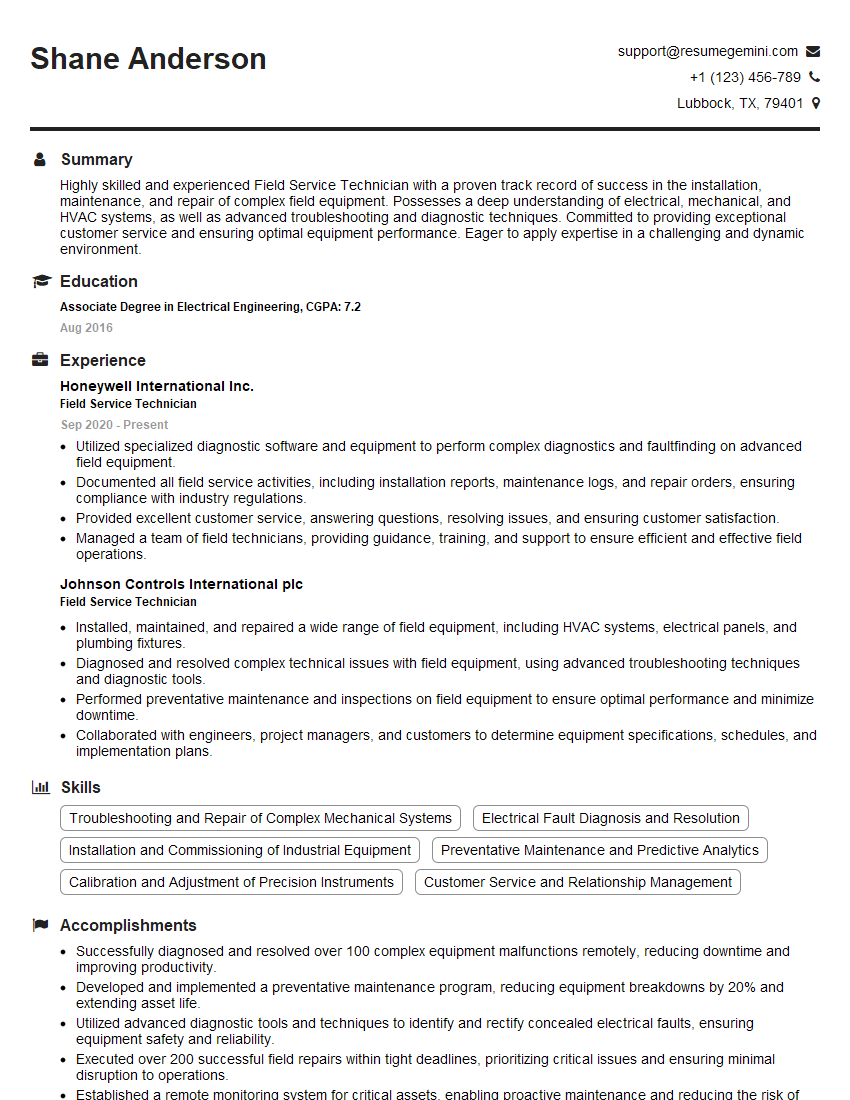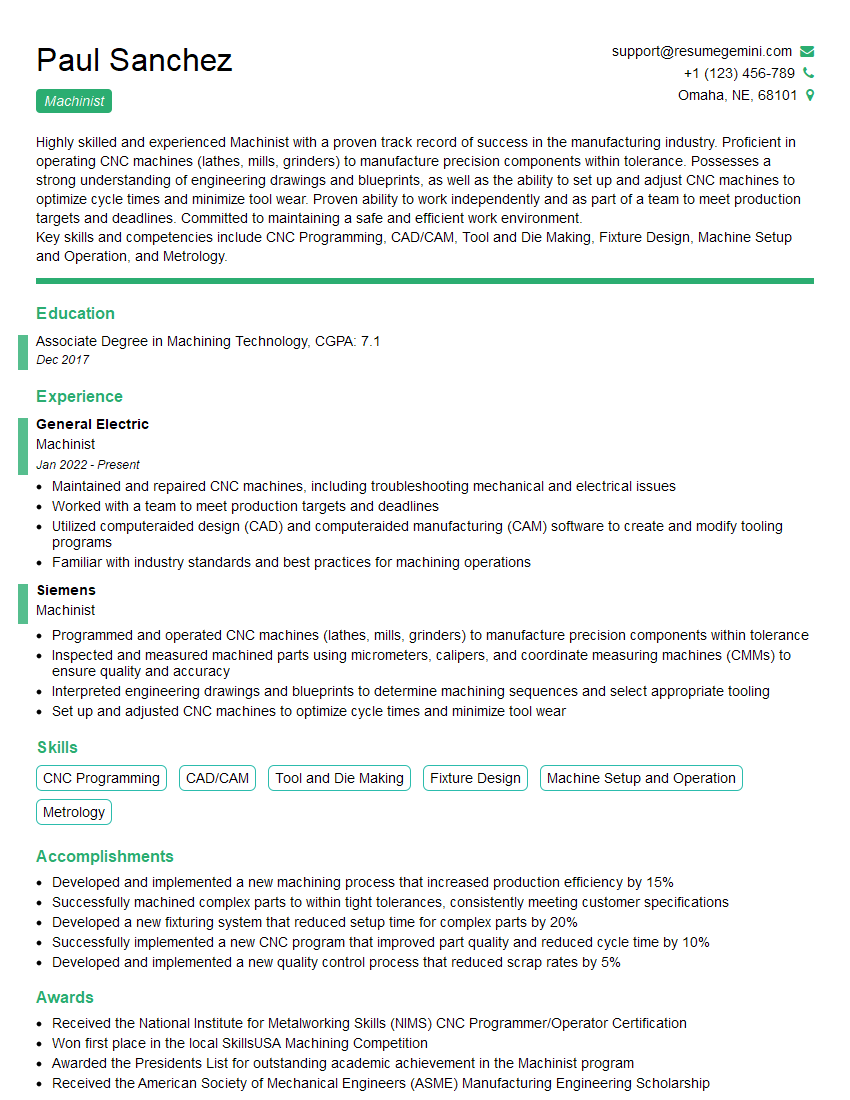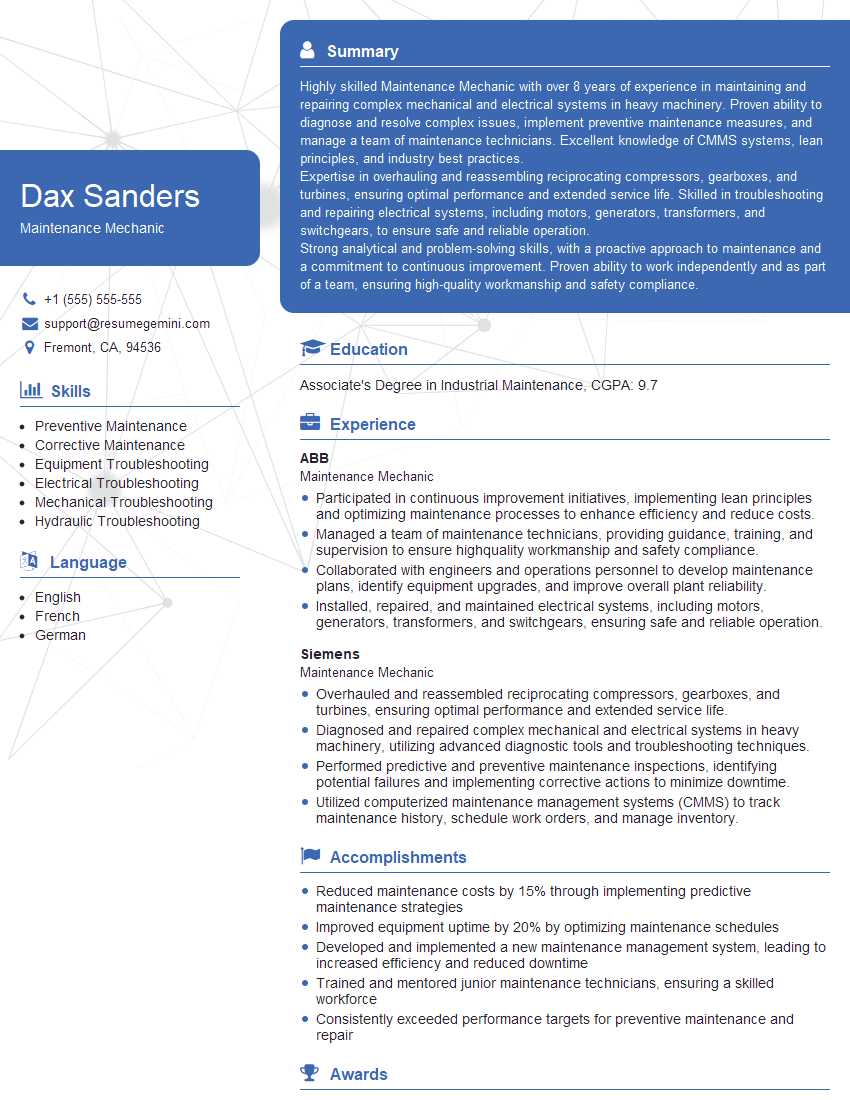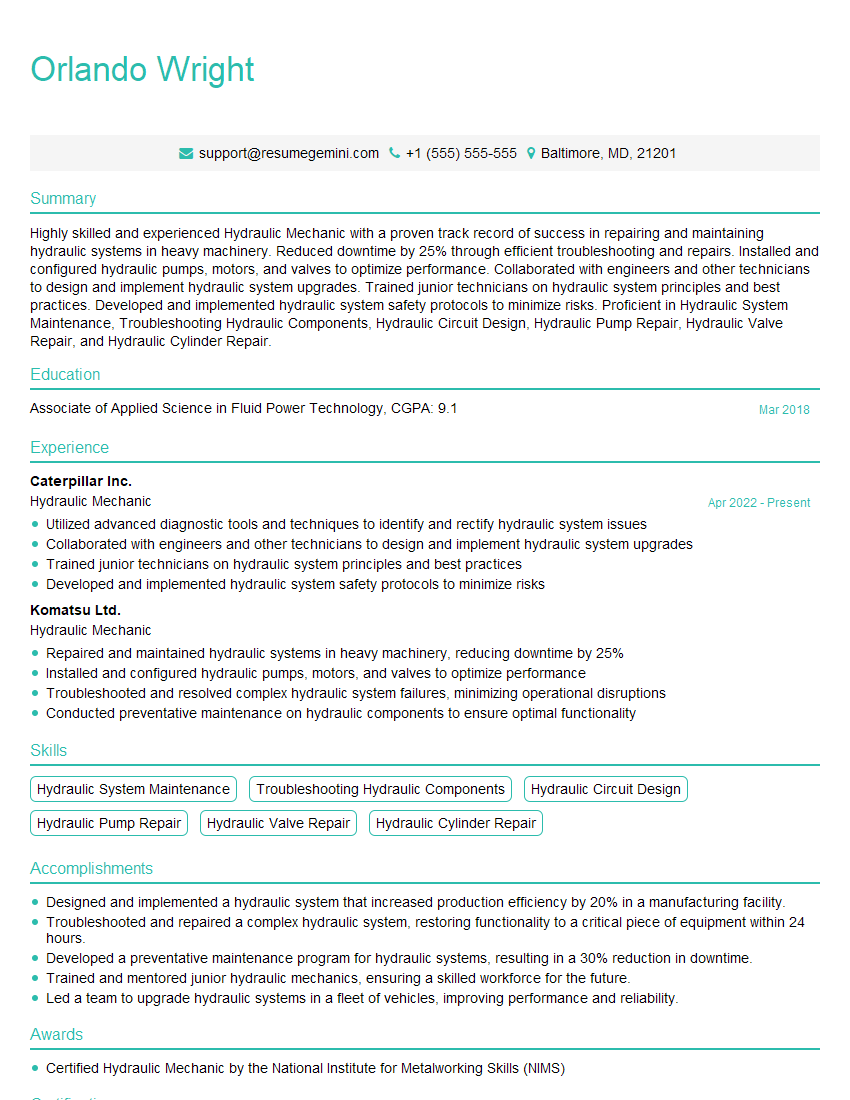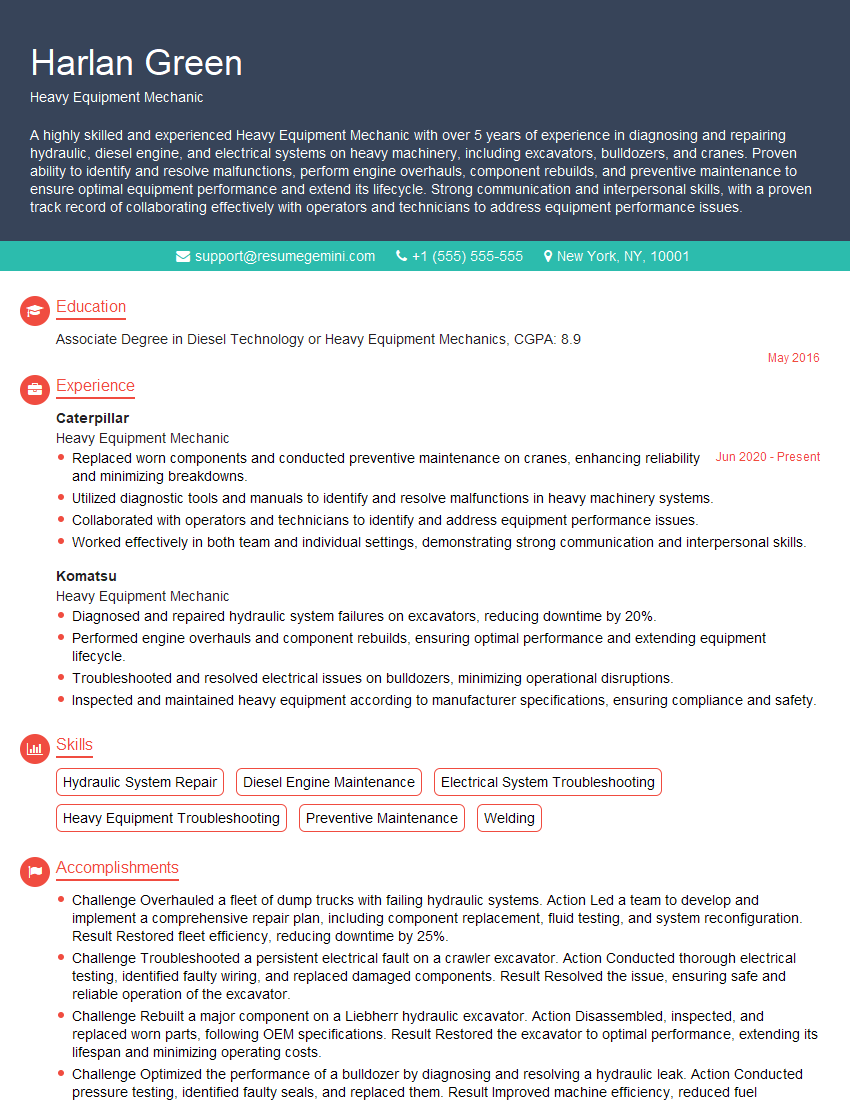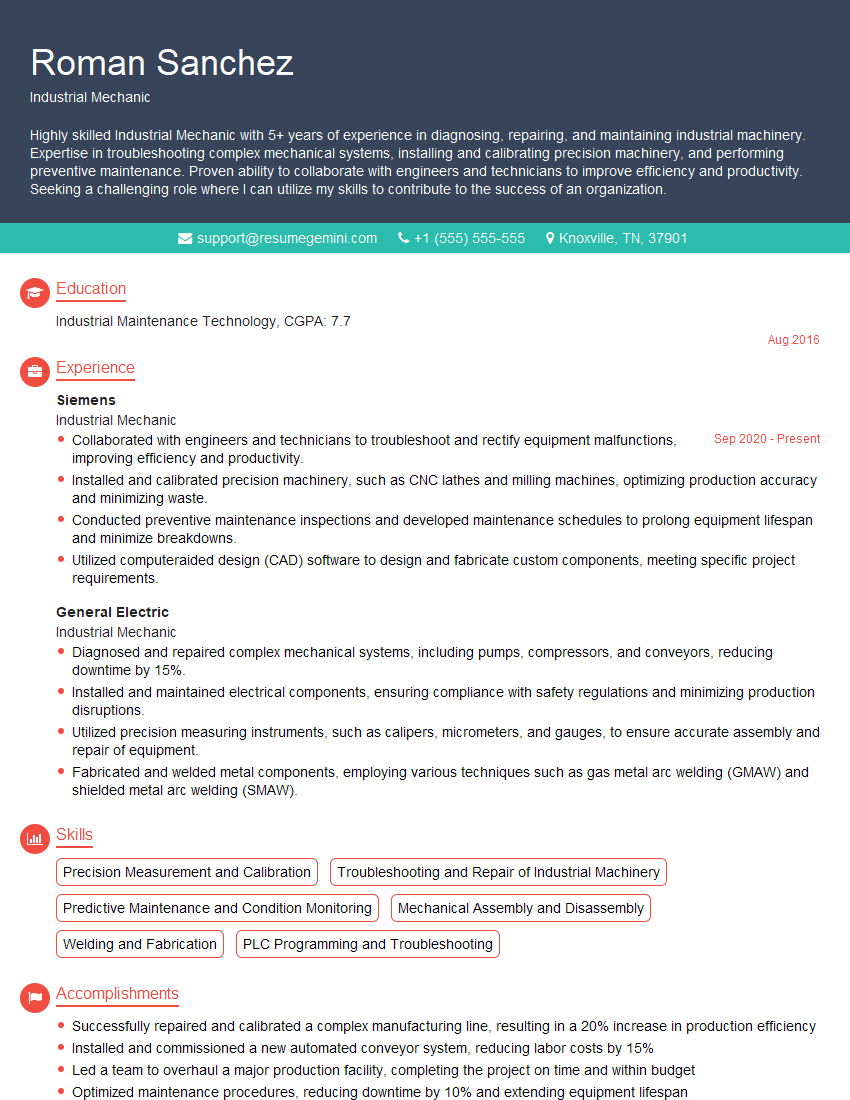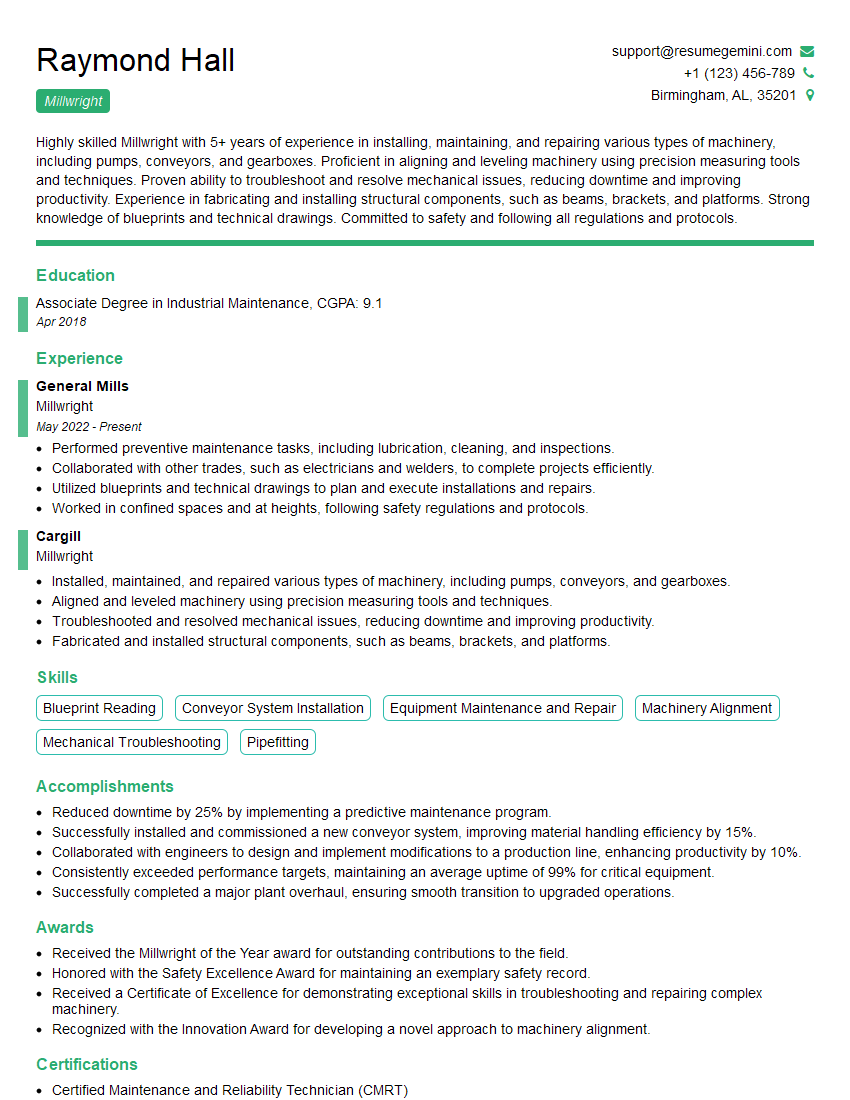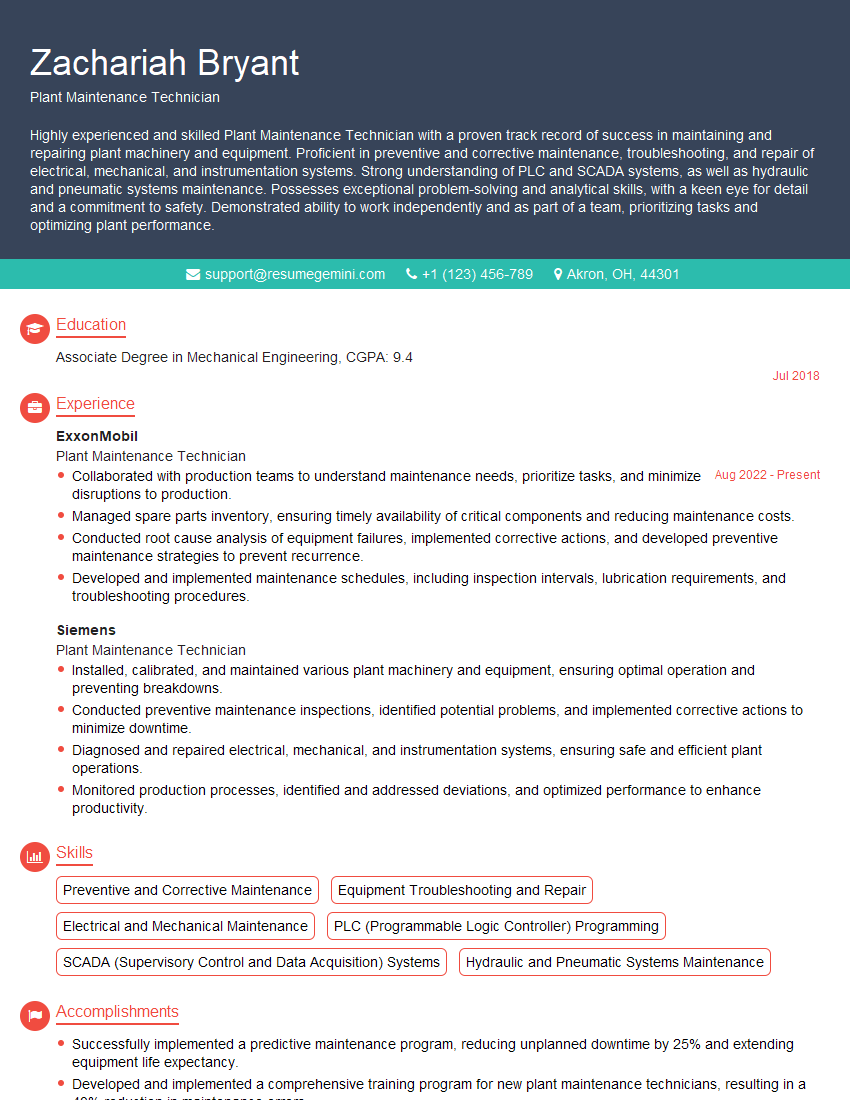Are you ready to stand out in your next interview? Understanding and preparing for Machinery Adjustment and Maintenance interview questions is a game-changer. In this blog, we’ve compiled key questions and expert advice to help you showcase your skills with confidence and precision. Let’s get started on your journey to acing the interview.
Questions Asked in Machinery Adjustment and Maintenance Interview
Q 1. Describe your experience with preventative maintenance procedures.
Preventative maintenance (PM) is the proactive process of inspecting, lubricating, and adjusting machinery to prevent breakdowns and extend its lifespan. Think of it like regular check-ups for your car – it’s much cheaper and less disruptive to catch small issues early than to wait for a major failure.
My experience encompasses developing and implementing PM schedules based on manufacturer recommendations and historical data. This includes tasks like:
- Regular Inspections: Visually checking for wear and tear, leaks, loose connections, and unusual noises on a defined schedule (daily, weekly, monthly, etc.).
- Lubrication: Applying the correct type and amount of lubricant to bearings, gears, and other moving parts to reduce friction and wear. This often involves understanding different lubrication systems, like grease guns for bearings or oil injection systems for gears.
- Adjustments: Fine-tuning machine components, such as belt tension, chain slack, and valve clearances, to ensure optimal performance and prevent premature wear.
- Data Analysis: Tracking PM activities and machine performance metrics (vibration, temperature, power consumption) to identify trends and potential issues before they escalate. For example, consistently high vibration readings on a specific bearing might indicate impending failure.
In a previous role, I implemented a new PM program for a packaging line, resulting in a 20% reduction in unplanned downtime and a 15% increase in overall production efficiency.
Q 2. Explain the process of troubleshooting a malfunctioning machine.
Troubleshooting a malfunctioning machine is a systematic process that requires a combination of observation, analysis, and problem-solving skills. It’s like detective work for machines!
My approach typically involves these steps:
- Safety First: Lock out the machine, ensuring it’s completely de-energized before beginning any troubleshooting.
- Gather Information: Document the symptoms. What exactly is wrong? When did the problem start? What were the conditions at the time of failure? Interview operators to understand their observations.
- Visual Inspection: Carefully examine the machine for obvious problems like loose connections, leaks, broken parts, or unusual wear.
- System Check: Check the inputs, outputs, and any interconnecting systems. Is there a lack of power, compressed air, or raw material? Are the sensors functioning correctly?
- Diagnostic Tools: Utilize tools like multimeters, vibration analyzers, and infrared thermometers to identify underlying issues. For example, a vibration analyzer can pinpoint the source of excessive vibration in a motor or bearing.
- Testing & Repair: Based on the diagnosis, conduct tests to confirm the problem and then perform the necessary repairs or replacements.
- Documentation: Meticulously document the troubleshooting steps, findings, and repairs made. This ensures future maintainability and contributes to preventative measures.
For example, I once resolved a production line stoppage by tracing a seemingly minor electrical fault to a corroded connection in a control panel. Careful observation and systematic troubleshooting, using a multimeter, led to a quick and efficient resolution.
Q 3. What are the common causes of machine vibration and how do you diagnose them?
Machine vibration is often a sign of underlying problems. Think of it as the machine ‘complaining’. Excessive vibration can lead to premature wear, component failure, and even catastrophic damage.
Common causes of machine vibration include:
- Unbalance: Uneven distribution of mass in rotating components like rotors or impellers. This is like an unbalanced washing machine – it vibrates excessively.
- Misalignment: Improper alignment of shafts, pulleys, or gears. This can cause significant vibration and wear.
- Looseness: Loose bearings, bolts, or other fasteners can lead to excessive vibration.
- Mechanical Defects: Worn bearings, damaged gears, or bent shafts can all cause vibration.
- Resonance: When the machine’s operating frequency matches its natural frequency, resulting in amplified vibrations.
- Fluid-Induced Vibrations: Cavitation or other flow issues in pumps or hydraulic systems can generate significant vibrations.
Diagnosing vibration involves using tools like vibration analyzers and accelerometers. These tools measure the frequency and amplitude of vibrations, helping pinpoint the source of the problem. Spectra analysis allows us to identify specific frequencies associated with different potential causes (e.g., 1X for unbalance, 2X for misalignment).
Q 4. How do you perform a scheduled lubrication procedure?
Scheduled lubrication is critical for minimizing friction, wear, and extending machine lifespan. It’s like keeping the moving parts of your machine ‘happy’.
My procedure for scheduled lubrication usually follows these steps:
- Safety First: Ensure the machine is locked out and de-energized before starting any lubrication task.
- Preparation: Gather the required lubricants (grease, oil), tools (grease gun, oil can), and cleaning materials (rags, solvents).
- Inspection: Check the lubrication points for existing lubricant levels and signs of leakage or contamination.
- Cleaning: Clean the lubrication points using appropriate solvents and rags to remove old, dirty lubricant.
- Lubrication: Apply the correct type and amount of lubricant to the specified points, following manufacturer recommendations. This often involves using grease guns for bearings or oil cans for other applications.
- Verification: Check the lubrication points again to ensure proper lubrication.
- Record Keeping: Document the date, time, location, lubricant used, and quantity applied.
In practice, I use both preventative maintenance schedules and condition monitoring data to optimize lubrication schedules. Excessive or insufficient lubrication can both be detrimental to equipment.
Q 5. Describe your experience with different types of machine alignment.
Machine alignment is crucial for optimal performance, minimizing vibration, and preventing premature wear. It’s like ensuring all the parts of a machine work together harmoniously.
I have experience with several types of machine alignment, including:
- Shaft Alignment: Ensuring that the shafts of connected machines (like motors and pumps) are precisely aligned to minimize vibration and bearing wear. Techniques include using alignment tools such as laser alignment systems or dial indicators.
- Pulley Alignment: Aligning pulleys to ensure proper belt tracking and prevent premature wear. This often involves using straight edges and alignment tools.
- Gear Alignment: Aligning gears to ensure smooth operation and prevent excessive wear. Precision is critical here to avoid tooth damage.
- Laser Alignment: This method uses laser technology for precise shaft alignment, providing accurate and repeatable results. It’s typically used for critical applications where high precision is required.
Each alignment method requires different tools and techniques, and the choice depends on the specific machine and application. For instance, laser alignment is preferred for high-speed rotating equipment where even slight misalignment can lead to significant problems.
Q 6. What safety precautions do you take when working on machinery?
Safety is paramount when working on machinery. My approach is based on a ‘prevention-first’ mindset.
Safety precautions I consistently take include:
- Lockout/Tagout (LOTO): Always following LOTO procedures to ensure that machinery is completely de-energized before working on it. This prevents accidental start-ups.
- Personal Protective Equipment (PPE): Wearing appropriate PPE, such as safety glasses, gloves, hearing protection, and steel-toed boots, depending on the task.
- Risk Assessment: Identifying and assessing potential hazards before starting work, planning mitigation strategies, and using appropriate safety procedures.
- Proper Lifting Techniques: Using proper lifting techniques to avoid injuries when handling heavy components.
- Awareness of Surroundings: Maintaining awareness of my surroundings and potential hazards, such as moving parts, sharp edges, or spills.
- Following Safety Regulations: Strictly adhering to all company safety regulations and procedures.
For example, before working on a high-voltage electrical panel, I always ensure the power is completely disconnected, the panel is locked out, and a tag is applied indicating that maintenance is in progress. This is a non-negotiable step for me.
Q 7. How familiar are you with different types of sensors and their applications in machinery?
Sensors play a vital role in modern machinery, providing real-time data on machine performance and condition. They’re like the machine’s ‘nervous system’.
I am familiar with various types of sensors and their applications, including:
- Vibration Sensors (Accelerometers): Measure vibration levels to detect imbalances, misalignments, and other mechanical problems.
- Temperature Sensors (Thermocouples, RTDs): Monitor temperature to detect overheating, which can indicate potential failures.
- Pressure Sensors: Measure pressure in hydraulic and pneumatic systems to detect leaks or other anomalies.
- Proximity Sensors: Detect the presence or absence of objects without physical contact, often used for position sensing or safety interlocks.
- Flow Sensors: Measure the flow rate of fluids in pipes or systems.
- Displacement Sensors: Measure the movement or position of machine parts.
These sensors are often integrated into machine control systems, providing valuable data for predictive maintenance and real-time monitoring. For example, using vibration sensors and predictive analytics, I can predict bearing failures before they occur, preventing costly downtime.
Q 8. Explain your experience with hydraulic and pneumatic systems.
My experience with hydraulic and pneumatic systems spans over ten years, encompassing design, maintenance, and troubleshooting. I’ve worked extensively with both systems in various industrial settings, from large-scale manufacturing plants to smaller production facilities. Hydraulic systems, utilizing pressurized fluids, are crucial for heavy lifting, precise movements, and power transmission. I’m proficient in identifying leaks, diagnosing pump failures, and understanding the role of valves, actuators, and reservoirs. For example, I once diagnosed a faulty hydraulic cylinder in a robotic arm by systematically checking pressure readings at each component, eventually pinpointing a damaged seal. Pneumatic systems, using compressed air, are often preferred for simpler, faster applications. My experience includes troubleshooting pneumatic circuits, repairing air leaks, and understanding the function of pressure regulators, valves, and actuators. A recent project involved optimizing a pneumatic system to reduce cycle time on a packaging line by strategically replacing some components with more efficient ones.
Q 9. Describe your experience with PLC programming and troubleshooting.
My PLC programming experience encompasses various platforms like Allen-Bradley, Siemens, and Schneider Electric. I’m proficient in ladder logic, structured text, and function block programming. I can design, implement, and debug PLC programs to control automated machinery, including conveyor systems, robotic arms, and CNC machines. Troubleshooting involves systematically using diagnostic tools to identify and resolve issues in the PLC code, I/O signals, and hardware. For instance, I recently resolved a production halt caused by a faulty sensor signal on a packaging machine. By analyzing the PLC program and using the diagnostic tools, I isolated the problem to a corroded connection, which was quickly repaired. I’m also familiar with HMI (Human Machine Interface) design and programming, allowing me to create user-friendly interfaces for operators.
Example Ladder Logic: IF sensor input THEN activate output.Q 10. How do you interpret technical manuals and schematics?
Interpreting technical manuals and schematics is fundamental to my work. I approach them systematically, starting with the overall system overview to understand the big picture before delving into specific components. I pay close attention to details, such as wiring diagrams, component specifications, and safety precautions. I use a combination of techniques, including cross-referencing information from different sections, comparing the schematic to the physical machine, and using online resources if necessary. Think of it like assembling a complex puzzle—each piece (manual section, schematic diagram) provides a clue to understanding the whole system. For example, when troubleshooting a complex machine, I use the schematics to trace the signal flow, identifying potential points of failure. I also refer to the manual for detailed component information, ensuring I select the right replacement parts during maintenance and repairs.
Q 11. What is your experience with using diagnostic tools?
My experience with diagnostic tools is extensive. I’m proficient in using multimeters, oscilloscopes, pressure gauges, temperature sensors, and specialized equipment like PLC programming software and vibration analyzers. Each tool serves a specific purpose; multimeters are used for checking voltage, current, and resistance; oscilloscopes analyze signal waveforms; and pressure gauges measure hydraulic and pneumatic system pressure. I choose the appropriate tool based on the specific problem I’m trying to diagnose. For instance, when diagnosing a machine that’s exhibiting erratic behavior, I might use an oscilloscope to check for electrical noise in the control signals, and then use a vibration analyzer to identify potential mechanical problems. Proper calibration and safe use of diagnostic tools are critical for accurate diagnosis and prevent potential damage.
Q 12. Describe your experience with machine repair and component replacement.
My experience in machine repair and component replacement is vast. I’ve worked on a wide range of machinery, from simple conveyors to complex robotic systems. The process typically begins with a thorough assessment of the problem, often involving the use of diagnostic tools. Once the faulty component is identified, I carefully plan the repair or replacement process, considering safety precautions, proper lockout/tagout procedures, and the availability of replacement parts. I follow manufacturer recommendations and best practices during component replacement, ensuring proper installation and alignment. For example, recently, I replaced a worn-out bearing in a high-speed centrifuge. This involved carefully dismantling the machine, removing the old bearing, precisely installing the new one, ensuring proper lubrication, and then reassembling the machine while adhering to the manufacturer’s specifications to prevent further damage.
Q 13. How do you prioritize maintenance tasks?
Prioritizing maintenance tasks involves a combination of factors, including criticality, urgency, and cost. I typically use a risk-based approach, prioritizing tasks that pose the greatest risk to production or safety. This often involves using a combination of methods such as CMMS (Computerized Maintenance Management System) software and predictive maintenance techniques. For example, I would prioritize repairing a malfunctioning safety system over a minor cosmetic issue. A CMMS system helps track scheduled maintenance, while predictive techniques such as vibration analysis and oil analysis can help identify potential problems before they lead to major failures, enabling proactive maintenance rather than reactive repair.
Q 14. How do you document maintenance activities?
Accurate documentation of maintenance activities is crucial for traceability, accountability, and continuous improvement. I typically use a combination of methods, including electronic logs via CMMS systems, physical work orders, and detailed reports. Each entry includes specific details such as date, time, task description, parts replaced, and any observations made during maintenance. Photos and diagrams are frequently included to provide a visual record of the work performed. This rigorous documentation enables efficient troubleshooting in the future, identifies recurring problems, and supports preventative maintenance planning. It also helps comply with safety regulations and industry best practices.
Q 15. Explain your understanding of Root Cause Analysis (RCA).
Root Cause Analysis (RCA) is a systematic process for identifying the underlying cause of a problem, rather than just addressing its symptoms. It’s crucial in machinery maintenance because fixing a symptom without understanding the root cause often leads to recurring issues. Think of it like treating a fever with aspirin – it lowers the temperature, but if the underlying infection isn’t addressed, the fever will return.
A common RCA methodology is the ‘5 Whys’. You repeatedly ask ‘Why?’ until you get to the root cause. For example, if a machine keeps jamming, you might ask:
- Why is the machine jamming? Because the parts are misaligned.
- Why are the parts misaligned? Because the bolts securing them loosened.
- Why did the bolts loosen? Because of excessive vibration.
- Why is there excessive vibration? Because of an imbalance in the rotating component.
- Why is there an imbalance? Because of improper balancing during assembly.
The root cause here is improper balancing during assembly. Addressing this prevents future jamming. Other RCA methods include Fishbone diagrams and Fault Tree Analysis, each providing structured approaches to systematically investigate the problem.
Career Expert Tips:
- Ace those interviews! Prepare effectively by reviewing the Top 50 Most Common Interview Questions on ResumeGemini.
- Navigate your job search with confidence! Explore a wide range of Career Tips on ResumeGemini. Learn about common challenges and recommendations to overcome them.
- Craft the perfect resume! Master the Art of Resume Writing with ResumeGemini’s guide. Showcase your unique qualifications and achievements effectively.
- Don’t miss out on holiday savings! Build your dream resume with ResumeGemini’s ATS optimized templates.
Q 16. What is your experience with different types of bearings and their maintenance?
My experience encompasses various bearing types, including ball bearings, roller bearings (cylindrical, tapered, spherical), and thrust bearings. Each has unique characteristics and maintenance needs. Ball bearings are common for lighter loads and high speeds, requiring regular lubrication and inspection for wear and tear. I’ve worked extensively with roller bearings in heavier-duty applications where higher load capacity is needed, focusing on proper alignment and monitoring for signs of damage like pitting or brinelling. Tapered roller bearings, for instance, require precise axial and radial adjustment to avoid premature failure.
Maintenance involves regular lubrication (using the correct grease or oil type and frequency), visual inspection for defects, and vibration analysis to detect early signs of wear. I’ve also utilized thermal imaging to identify overheating bearings, indicating potential problems like insufficient lubrication or misalignment. For example, I once diagnosed a bearing failure on a large conveyor system by detecting an unusual temperature rise using infrared thermography; replacing the bearing preemptively avoided a major production downtime.
Q 17. Describe your experience with belt drives and chain drives.
I have significant experience with both belt and chain drives. Belt drives are simpler and quieter, often used for lower torque applications. Maintenance focuses on proper tension, alignment, and condition of the belts themselves; checking for wear, cracks, and slippage. I’ve worked with various belt materials – V-belts, toothed belts (synchronous belts), and flat belts – each requiring slightly different maintenance procedures. For instance, V-belts require the correct tension to prevent slippage but not excessive tension that causes premature wear.
Chain drives, on the other hand, are more robust and efficient for higher torque and speed applications. Their maintenance focuses on lubrication (with the correct type of lubricant and frequency), chain slack adjustment, and wear inspection of sprockets and chain links. I’ve addressed issues like chain elongation, sprocket wear, and lubrication failure, which often result in noisy operation and reduced efficiency. A recent project involved optimizing chain lubrication on a packaging machine, reducing wear and noise significantly, and extending the lifespan of the chain drive.
Q 18. How familiar are you with different types of welding techniques?
My familiarity with welding techniques extends to several common methods, including Shielded Metal Arc Welding (SMAW or stick welding), Gas Metal Arc Welding (GMAW or MIG welding), Gas Tungsten Arc Welding (GTAW or TIG welding), and resistance welding (spot and seam welding). Each has its strengths and weaknesses depending on the material being welded and the desired outcome.
SMAW is versatile but requires more skill to produce high-quality welds, whereas GMAW is faster and often preferred for production work. GTAW is excellent for precision welding and clean welds, but it is a more time-consuming process. Resistance welding is ideal for joining sheets of metal rapidly. In my experience, proper weld preparation, selection of appropriate welding parameters (voltage, amperage, wire feed speed), and adherence to safety procedures are paramount to ensure strong and reliable welds.
For instance, I once used TIG welding to repair a crack in a critical component of a hydraulic press, requiring precision to avoid compromising the structural integrity. I also regularly utilize MIG welding for maintenance repairs in industrial settings.
Q 19. Explain your experience with electrical troubleshooting in machinery.
Electrical troubleshooting is a crucial aspect of machinery maintenance. My experience includes identifying and resolving issues with motors, control circuits, sensors, and wiring. I am proficient in using multimeters, oscilloscopes, and other diagnostic tools to pinpoint problems such as short circuits, open circuits, faulty components, and incorrect wiring.
My approach typically starts with a visual inspection, followed by systematic testing using appropriate instruments. For example, if a motor fails to start, I’d first check the power supply, then the motor’s windings for continuity and shorts, and finally inspect the associated control circuitry. Understanding electrical schematics and ladder diagrams is essential for effective troubleshooting. I’ve also utilized programmable logic controllers (PLCs) for diagnosis and programming in various automated systems. A recent example involves diagnosing a faulty proximity sensor on a robotic arm, using an oscilloscope to identify the intermittent signal issue leading to the malfunction.
Q 20. How do you handle unexpected machine breakdowns?
Unexpected machine breakdowns demand a quick and efficient response. My approach follows a structured process:
- Safety First: Ensure the immediate safety of personnel and isolate the machine to prevent further damage or injury.
- Assessment: Quickly assess the situation, identifying the nature of the breakdown and its potential impact on production.
- Troubleshooting: Utilize my diagnostic skills (electrical, mechanical, hydraulic, pneumatic) to pinpoint the cause of the breakdown. This may involve checking safety interlocks, pressure gauges, temperature sensors, or using diagnostic tools.
- Repair or Replacement: Based on the diagnosis, either repair the faulty component or replace it with a spare. If the problem is complex, I’ll document the issue and consult with colleagues or specialists.
- Restoration: Once the repair is complete, thoroughly test the machine to ensure it operates correctly and safely.
- Documentation: Document the breakdown, the repair process, and any preventative measures to avoid similar occurrences in the future. This forms the basis for root cause analysis.
A recent example involves a sudden hydraulic fluid leak on a punch press. By quickly isolating the machine, identifying the leaking component (a faulty hydraulic hose), and replacing the hose, I minimized downtime and avoided potential damage.
Q 21. What is your experience with predictive maintenance techniques?
Predictive maintenance utilizes data analysis and sensor technology to anticipate potential equipment failures before they occur. This reduces unexpected downtime and optimizes maintenance schedules. My experience includes working with various predictive maintenance techniques, such as vibration analysis, oil analysis, infrared thermography, and ultrasonic testing.
Vibration analysis helps detect imbalances, misalignments, and bearing wear. Oil analysis reveals the condition of lubricants and identifies contaminants indicating wear in components. Infrared thermography identifies overheating components, which can be an early warning of impending failure. Ultrasonic testing is used to detect leaks in pressurized systems. By collecting and analyzing data from these methods, I can create predictive models to anticipate equipment failure and plan maintenance accordingly. For instance, by monitoring the vibration levels of a critical pump over time, I was able to predict a bearing failure several weeks in advance, allowing for a scheduled replacement during a low-production period, avoiding costly unplanned downtime.
Q 22. Describe a time you had to solve a complex maintenance problem.
One of the most challenging maintenance issues I faced involved a critical production line’s unexpected shutdown. The automated palletizer, a crucial component, had developed a recurring jamming issue causing significant production downtime. Initially, the problem seemed straightforward – a simple sensor malfunction. However, after replacing the sensor, the problem persisted. This led me to conduct a thorough investigation.
My systematic approach involved:
- Careful Observation: I spent hours observing the machine’s operation, noting the precise timing and conditions under which the jams occurred.
- Data Analysis: I reviewed the machine’s logs and performance data, looking for patterns or anomalies. This revealed that jams happened more frequently during peak production periods, indicating a potential overload issue.
- Mechanical Inspection: I meticulously inspected the palletizer’s mechanical components, paying close attention to wear and tear. I discovered that the conveyor belt’s tension was inconsistent, causing product misalignment, leading to jams.
- Testing and Adjustments: After tightening the conveyor belt and fine-tuning the palletizer’s timing settings, the problem was resolved.
This experience reinforced the importance of a systematic, data-driven approach to troubleshooting and the need to go beyond immediate solutions to uncover root causes. It highlighted the value of observation, analysis, and hands-on mechanical understanding in resolving complex maintenance issues.
Q 23. How do you stay updated on new maintenance technologies and techniques?
Staying updated in the rapidly evolving field of machinery maintenance requires a multi-pronged approach. I actively engage in several methods to ensure my knowledge remains current:
- Professional Associations: I’m a member of several professional organizations, such as the Society for Maintenance & Reliability Professionals (SMRP), which provides access to industry publications, conferences, and networking opportunities.
- Online Courses and Webinars: Platforms like Coursera, edX, and LinkedIn Learning offer valuable courses on advanced maintenance techniques, predictive maintenance, and new technologies like AI in maintenance.
- Industry Publications and Journals: I regularly read industry publications and journals that feature the latest research, best practices, and case studies in maintenance and reliability.
- Manufacturer Training and Certifications: I actively seek out training and certifications offered by equipment manufacturers, allowing me to stay up-to-date on specific machine models and their maintenance requirements. This often involves hands-on workshops and simulations.
- Networking: Attending industry conferences and workshops allows me to network with colleagues, learn about their experiences, and share best practices.
This combination of formal and informal learning keeps me abreast of the latest advancements in the field.
Q 24. What are your strengths and weaknesses in machinery maintenance?
My strengths lie in my analytical and problem-solving abilities, combined with a strong practical understanding of machinery maintenance. I’m adept at diagnosing complex issues, developing effective repair strategies, and implementing preventative maintenance programs. My experience with various types of machinery, coupled with my proficiency in using diagnostic tools and software, makes me a valuable asset.
However, one area I’m continuously working to improve is my project management skills. While I excel at executing individual tasks, I recognize the need to enhance my ability to manage larger maintenance projects with multiple stakeholders and deadlines more effectively. I’m addressing this by taking online project management courses and seeking opportunities to lead smaller maintenance projects within my current role.
Q 25. What are your salary expectations?
Based on my experience and skills, and considering the responsibilities associated with this position, my salary expectations are in the range of [Insert Salary Range]. However, I am open to discussing this further based on the complete compensation package and the specifics of the role.
Q 26. Why are you interested in this position?
I’m highly interested in this position due to several factors. First, [Company Name]’s reputation for innovation and commitment to excellence aligns perfectly with my professional values. I’m particularly impressed by [Mention specific company achievement, project, or value]. Second, the opportunity to work with [Mention specific machinery or technology] is very appealing given my experience and interest in [related field]. Finally, the challenges presented by this role, including [mention specific responsibilities], offer an excellent platform for me to leverage my expertise and continue to grow professionally.
Q 27. Where do you see yourself in 5 years?
In five years, I envision myself as a highly skilled and respected member of your maintenance team, contributing significantly to the company’s operational efficiency and productivity. I hope to have taken on increased responsibility, potentially leading projects and mentoring junior technicians. I’m also eager to continue developing my expertise in [Specific area of expertise, e.g., predictive maintenance, automation] and contributing to the implementation of new technologies to improve maintenance processes.
Q 28. Do you have any questions for us?
Yes, I have a few questions. First, could you elaborate on the company’s plans for implementing new maintenance technologies in the future? Second, what are the typical career progression paths for maintenance technicians within the company? Finally, what opportunities are there for professional development and continuing education?
Key Topics to Learn for Machinery Adjustment and Maintenance Interview
- Preventive Maintenance: Understanding schedules, lubrication techniques, and inspection procedures to minimize downtime and extend equipment lifespan. Practical application: Developing and implementing a preventative maintenance plan for a specific machine type.
- Troubleshooting and Diagnostics: Identifying malfunctions through systematic analysis, utilizing diagnostic tools, and interpreting error codes. Practical application: Diagnosing the cause of a machine malfunction and outlining the repair procedure.
- Hydraulic and Pneumatic Systems: Understanding the principles of hydraulic and pneumatic systems, including components, troubleshooting common issues, and safety procedures. Practical application: Explaining the function of a hydraulic actuator and diagnosing a leak in a pneumatic system.
- Mechanical Systems: Knowledge of gears, bearings, shafts, belts, and other mechanical components; understanding wear and tear, lubrication, and replacement procedures. Practical application: Analyzing the wear patterns on a gear system and recommending preventative measures.
- Electrical Systems (Basic): Familiarity with basic electrical components relevant to machinery, including motors, sensors, and control systems. Practical application: Understanding the function of a proximity sensor and its role in machine operation.
- Safety Procedures and Regulations: Demonstrating a strong understanding of safety protocols, lockout/tagout procedures, and relevant industry regulations. Practical application: Describing the correct procedure for performing maintenance on a machine with exposed moving parts.
- Record Keeping and Documentation: Understanding the importance of accurate and complete maintenance logs, including parts used, time spent, and any issues encountered. Practical application: Creating a comprehensive maintenance report for a specific machine.
- Root Cause Analysis: Applying problem-solving techniques to identify the underlying cause of recurring issues and implementing effective solutions. Practical application: Investigating repeated failures in a particular machine component and proposing a solution to prevent future occurrences.
Next Steps
Mastering Machinery Adjustment and Maintenance opens doors to rewarding careers with excellent growth potential. Advancement opportunities often require a strong technical foundation combined with excellent communication and problem-solving skills. To significantly boost your job prospects, create an ATS-friendly resume that highlights your abilities and experience effectively. ResumeGemini is a trusted resource that can help you build a professional resume that stands out. Examples of resumes tailored to Machinery Adjustment and Maintenance are available to guide you. Take the next step towards your career success!
Explore more articles
Users Rating of Our Blogs
Share Your Experience
We value your feedback! Please rate our content and share your thoughts (optional).
What Readers Say About Our Blog
Hi, I have something for you and recorded a quick Loom video to show the kind of value I can bring to you.
Even if we don’t work together, I’m confident you’ll take away something valuable and learn a few new ideas.
Here’s the link: https://bit.ly/loom-video-daniel
Would love your thoughts after watching!
– Daniel
This was kind of a unique content I found around the specialized skills. Very helpful questions and good detailed answers.
Very Helpful blog, thank you Interviewgemini team.
